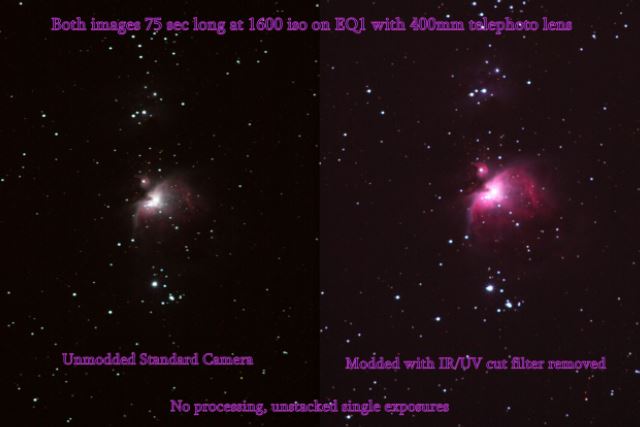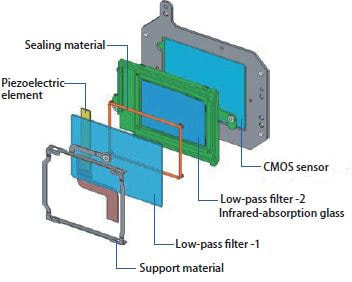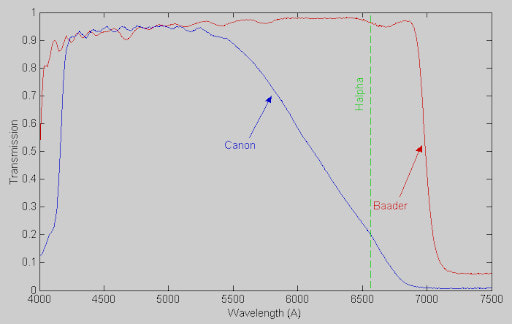Astro-modified cameras and repairs

Why mod a camera for astronomy?
Canon DSLR cameras have two filters in front of the sensor, cutting out unwanted Ultra Violet and Infrared light and drastically reducing the amount of red light to make images look ‘normal’ to the human eye. If the 2nd colour/Infrared cut filter is removed (or replaced with a specialist Baader filter) the camera becomes much more sensitive, leading to shorter exposures, and more importantly, to ‘seeing’ more of the H-alpha light (e.g. the red in nebulae).
Canon DSLR cameras have two filters in front of the sensor, cutting out unwanted Ultra Violet and Infrared light and drastically reducing the amount of red light to make images look ‘normal’ to the human eye. If the 2nd colour/Infrared cut filter is removed (or replaced with a specialist Baader filter) the camera becomes much more sensitive, leading to shorter exposures, and more importantly, to ‘seeing’ more of the H-alpha light (e.g. the red in nebulae).

There are 3 main types of modification:
1 – Full spectrum, both lpf filters are removed and replaced with one of clear glass, can be used to image any spectrum, but every image must be made through a selective filter. Only recommended if you want to image IR and or UV, as the images are almost entirely red. Unless an expensive additional clip in filter is used it will not be suitable for astrophotography. UV 'washes' over the images leaving a blurred whitecast image.
2 – Enhanced spectrum, Ipf2 is removed and the camera sensor is re-shimmed for correct autofocus. The downside of this modification is that images will be a bit pink, but this can be removed in post processing or the camera can be adjusted to compensate. The sensor will also be able to 'see' the IR spectrum and through multi-layered cost-effective glass optics some star bloat may be caused. The advantage is that the camera can be used as a ‘normal’ camera (with custom RGB settings and in any mode other than full auto), as well as an astro-camera and can, using screw in or clip filters image in IR.
3 – Baader filter modification (clipped spectrum) – colours are more natural and there are sharp cut offs to the UV and IR spectrums. There is no star bloat when this filter is used, regardless of optics. This option is excellent for colour astrophotography, as there are no additional filters required and the camera can also be used as an every-day normal camera. The spectrum is only slighted shifted, reds are a little brighter. Pin sharp stars with no ‘bloat’ and no IR/UV leakage into the image.
1 – Full spectrum, both lpf filters are removed and replaced with one of clear glass, can be used to image any spectrum, but every image must be made through a selective filter. Only recommended if you want to image IR and or UV, as the images are almost entirely red. Unless an expensive additional clip in filter is used it will not be suitable for astrophotography. UV 'washes' over the images leaving a blurred whitecast image.
2 – Enhanced spectrum, Ipf2 is removed and the camera sensor is re-shimmed for correct autofocus. The downside of this modification is that images will be a bit pink, but this can be removed in post processing or the camera can be adjusted to compensate. The sensor will also be able to 'see' the IR spectrum and through multi-layered cost-effective glass optics some star bloat may be caused. The advantage is that the camera can be used as a ‘normal’ camera (with custom RGB settings and in any mode other than full auto), as well as an astro-camera and can, using screw in or clip filters image in IR.
3 – Baader filter modification (clipped spectrum) – colours are more natural and there are sharp cut offs to the UV and IR spectrums. There is no star bloat when this filter is used, regardless of optics. This option is excellent for colour astrophotography, as there are no additional filters required and the camera can also be used as an every-day normal camera. The spectrum is only slighted shifted, reds are a little brighter. Pin sharp stars with no ‘bloat’ and no IR/UV leakage into the image.

The 'starbloat' is a blurring around a star causing the stars to appear larger.
Each spectrum of light focuses at a slightly different point, optical coatings help to reduce this.
Because IR and UV light is at the far sides of the visible spectrum the focus point for this is much further away.
If your camera 'sees' this it will cause blurring.
For example
To image in IR you have to focus in a different position than for 'normal' light.
Older camera lenses show this position marked on the lense.
To use, focus as normal, attach the IR filter, then refocus to the corresponding mark.
Each spectrum of light focuses at a slightly different point, optical coatings help to reduce this.
Because IR and UV light is at the far sides of the visible spectrum the focus point for this is much further away.
If your camera 'sees' this it will cause blurring.
For example
To image in IR you have to focus in a different position than for 'normal' light.
Older camera lenses show this position marked on the lense.
To use, focus as normal, attach the IR filter, then refocus to the corresponding mark.
Additional to the modifications I also have some astrophotography modified cameras in stock. They come with batteries, USB lead, memory card and charger. They are refurbished and have live view capability. Cameras are modified to the enhanced spectrum, with ipf2 filters removed, re-shimmed and custom RGB level set to allow use as ‘normal’ cameras.
I also try to help with repairs for older models, for example shutter failures or broken screens.
I also try to help with repairs for older models, for example shutter failures or broken screens.

